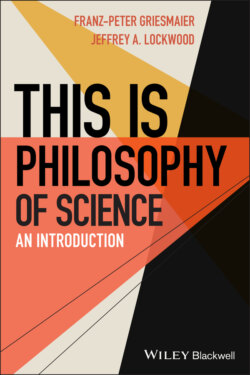Читать книгу This is Philosophy of Science - Franz-Peter Griesmaier - Страница 38
3.2.2 Falsification to the Rescue
ОглавлениеThis problem led some philosophers to abandon any attempt to confirm theories and to look at the situation from a different perspective. The Austrian philosopher Karl Popper introduced the twin notions of falsification and corroboration to describe how we (should) go about selecting the theories we accept. The idea is fairly straightforward and starts with the observation that while we cannot conclusively confirm any theory, we can conclusively falsify a theory. Take our example involving the color of ravens. Perhaps 200 ravens might be good evidence for the claim that all ravens are black; 2000 black ravens would be even better evidence. However, no matter how many ravens you manage to observe, you can never conclusively establish that all of them are black. But you can conclusively establish that not all of them are black, should that be indeed the case. How? Simply find a raven that is not black. In other words, one counterexample to the claim that all ravens are black suffices to falsify it. The general model of this process is very similar to that of confirmation by prediction, with the important exemption that the predicted observation is not made:
Raven Theory predicts “Next raven is black”
Observation “Next raven is black” is not made
Raven Theory is falsified
Popper made falsification the hallmark of his approach. Scientists, on his view, conjecture all sorts of theories and hypotheses. Whether any of them are worth keeping depends on two factors: How much do they tell us about reality, and whether or not they have been falsified. If we find a theory that has a lot of empirical content, and that we have not been able to falsify despite subjecting it to rigorous testing, we consider it as worth keeping. Popper’s technical term for “not falsified after rigorous testing” is “corroborated.” Thus, a theory is corroborated to the degree to which we have tried to falsify it and failed to do so. Highly corroborated theories are those worth keeping.
Why is having a lot of empirical content important, and how do we measure the content? First, theories with little to no content are not easily falsifiable. Suppose you restrict your raven theory in the following way: “All the ravens in my raven coop are black.” Unless you have overlooked a raven in your coop, nothing can falsify this theory. It is so specific that there are not many falsifiers. As such, it is not a very interesting theory. So, let’s be a little more daring: “All ravens in my yard are black.” Ravens come and go, and so it might turn out that one morning, you get up and discover that a maroon raven is perched on a tree limb in your yard. However, even this daring theory is still a far cry from the original theory we considered, according to which all ravens are black. Clearly, it has a lot more content – talks about a lot more things – than the theory about the ravens in the coop. Since it talks about more things, there are more things that can falsify it. Thus, we can now answer, at least in principle, the question how we should measure the content of a theory. To a first approximation, the content simply is the set of things that could falsify it, were you to observe them.
To summarize. Theories that involve universal generalizations, such as “all ravens are black,” can never be conclusively confirmed. They can, however, be conclusively falsified, or so Popper claimed. Theories that survive a lot of serious attempts to falsify them have proven their worth: they are corroborated. What science aims for is corroborated theories. Thus, we don’t need a theory of confirmation. Problem solved.
